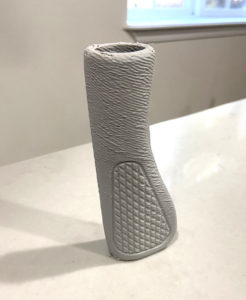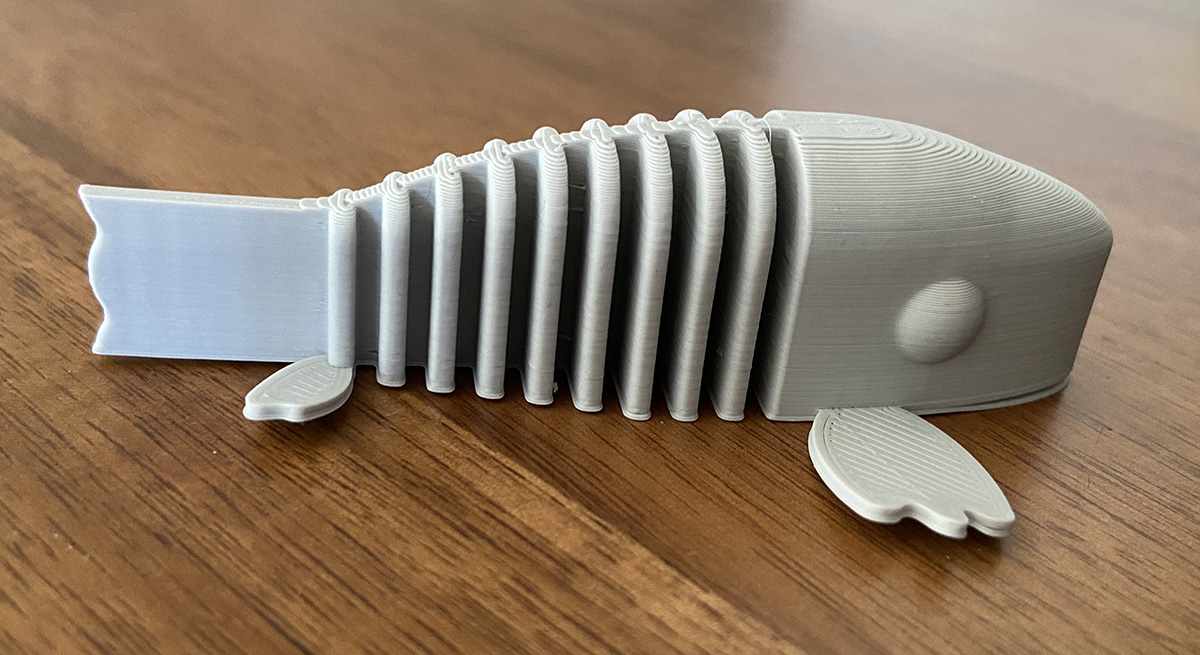NinjaTek has long been synonymous with 3D printing, due to the widespread use of NinjaFlex flexible 3D printing filaments. Circa 2015, the company developed two new filaments, Cheetah and Armadillo, which was followed by the electrically conductive, flexible material, Eel. Now, NinjaTek has released a new filament called Chinchilla, a 75A durometer series of thermoplastic elastomers (TPEs). 3DPrint.com was able to get ahold of the new material and give it a test run.
While Cheetah was meant for fast printing and Armadillo was as tough and rigid as its namesake, Chinchilla has the honor of being extremely soft like a, well, Chinchilla. Though Chinchilla is soft to the touch, it has the additional advantage of easy printability. Nearly all flexible filaments can be a bit of a struggle, typically requiring a direct drive extruder and comparatively slow printing speeds. Chinchilla, however, is able to print with direct drive and Bowden extruders. It’s also meant to offer “rebound, impact resistance, and a durability and matte finish that yields smoother, longer-lasting printed parts.”
Upon loading it into an Ultimaker 2+, it came out instantly. There was no struggle with the filament being pulled up into the feeder tube, which I had seen happen using a standard flexible material in the past. It then extruded smoothly out of the head without clogging. The real test, however, would be actually printing something.
The machine I was using happened to have a broken Z-switch, which I didn’t learn until after I’d already loaded the material. I was instantly worried that, as I awaited a replacement Z-axis sensor, the Chinchilla would dry out, as I didn’t have a proper storage solution. Fortunately, I was told by the NinjaTek folks, this material doesn’t require any silica packets or dehumidifying.
Once I got the machine up and running, I was eager to see if the material had survived the same ambient conditions as a spool of PLA and it had. I leveled the bed, hoping to ensure it was close enough for proper adhesion, since I knew flexible filaments can sometimes struggle with getting the first layer to stick.
When I began printing a watchband model supplied to me by NinjaTek, I was amazed with the fact that the first print went off without a hitch. There was no problem with bed adhesion. The filament didn’t get tangled on the spool, which can happen with just about any material in a cramped, sloppy setup such as mine but occurs more frequently with loose, spaghetti-like elastomeric filaments. I easily removed the band off the bed and examined it. The infill didn’t quite seem complete on the topmost layers, but that was likely due to print settings.

3D printed bike handlebar. Very squishy. Was told that, with some setting refinement, the texture would have been smoother.
To test the machine further, I printed a bike handle, also provided to me by NinjaTek. Again, the object adhered to the bed perfectly. There was a bit of a rough surface texture on parts of the handle that may have had to do with print settings. Nevertheless, it was soft and squishy and conjured up the possibilities for ergonomic designs for bike handles, helmet pads and more.
The reason for the watchband and bike handle files was that the company believes that the soft, rubbery material will prove successful in wearables, sports, medical devices and prosthetics. In particular, the team thinks an easy, but very useful application may be in patient-specific sleeves for prosthetics, an as-of-yet little explored area. Chinchilla has been validated with independent, third-party testing against the EpiDerm Skin Model, meaning that it is safe for skin contact.
“The 3D printing market was valued at $13.7 billion last year and is expected to rise to $63.46 billion by 2026, demonstrating strong consumer interest and demand,” said Sean Gablehouse, Business Manager of NinjaTek. “Chinchilla was specifically engineered to address such demand and the quality and usability concerns raised by 3D printing enthusiasts.”
I next tested the material with a few models I had selected myself, including a sandal, to demonstrate the possibilities for wearables, and some toys, to demonstrate the possibilities for my son. This time around, however, I ran into issues with the filament that seemed to have had something to do with first layer adhesion.
Because the material profile was not yet available on the Cura marketplace, I had to nail down the settings. There were several issues that I’m sure would not occur with other users once a material profile is made available for Cura or other slicer software. The most obvious was that I was using retraction settings that were double what they should have been. I had pulled these figures from NinjaTek Armadillo, a 75D rigid filament which has just about the opposite physical properties as the 75A Chinchilla.

Various tests with Benchy to refine the settings, performed with the help of Associate Application Engineer Michael Crotti at NinjaTek. This would likely not be necessary when the Cura profile for Chinchilla is made available.
So, lowering the retraction distance from 6.5 mm to 0 mm and the retraction speed from 35 mm/s to 15 mm/s was the first step to addressing my problems. Next, I increased the printing temperature to 240°C from 225°C and lowered the printing speed from 25 mm/s to 18 mm/s. This resulted in the same near-perfect prints as I previously created. In the end, I was able to get things running properly, which I can’t say for every filament I’ve tested.
In addition to the new material, NinjaTek has launched a new website, which provides all of the NinjaTek products as well as educational resources and case studies. A Community section also allows users of said products to connect, share tips and projects.
Additionally, the company is launching a Chinchilla 3D printing contest that starts May 1, 2021 and extends until July 31, 2021. Participants will submit a picture and/or video of new items made with the material. First through fourth-prize winners will announced August 16, 2021 and will take home a variety of NinjaTek gear, with the grand prize getting four spools of Chinchilla, along with individual spools of NinjaFlex, Cheetah, and Armadillo, along with a NinjaTek t-shirt. Register here for the competition.
It’s worth noting that Fenner Precision Polymers was acquired by the French Michelin Group in 2018, meaning that the French tiremaker has extended its reach both in polymers and metal 3D printing. So, while Fenner can provide its expertise in making precision belts for industrial processes to its filament line, Michelin is one of the largest tire manufacturers worldwide. This surely lends itself to a better product in the end.
From this author’s experience, the expertise is visible in the latest material from NinjaTek. Chinchilla offers not only extremely easy user experience, but results in velvety-soft, durable prints that are sure to be much more viable for wearables and other skin-facing items that previous filaments just weren’t suited to.
Subscribe to Our Email Newsletter
Stay up-to-date on all the latest news from the 3D printing industry and receive information and offers from third party vendors.
You May Also Like
Profiling a Construction 3D Printing Pioneer: US Army Corps of Engineers’ Megan Kreiger
The world of construction 3D printing is still so new that the true experts can probably be counted on two hands. Among them is Megan Kreiger, Portfolio Manager of Additive...
US Army Corps of Engineers Taps Lincoln Electric & Eaton for Largest 3D Printed US Civil Works Part
The Soo Locks sit on the US-Canadian border, enabling maritime travel between Lake Superior and Lake Huron, from which ships can reach the rest of the Great Lakes. Crafts carrying...
Construction 3D Printing CEO Reflects on Being Female in Construction
Natalie Wadley, CEO of ChangeMaker3D, could hear the words of her daughter sitting next to her resounding in her head. “Mum, MUM, you’ve won!” Wadley had just won the prestigious...
1Print to Commercialize 3D Printed Coastal Resilience Solutions
1Print, a company that specializes in deploying additive construction (AC) for infrastructure projects, has entered an agreement with the University of Miami (UM) to accelerate commercialization of the SEAHIVE shoreline...































